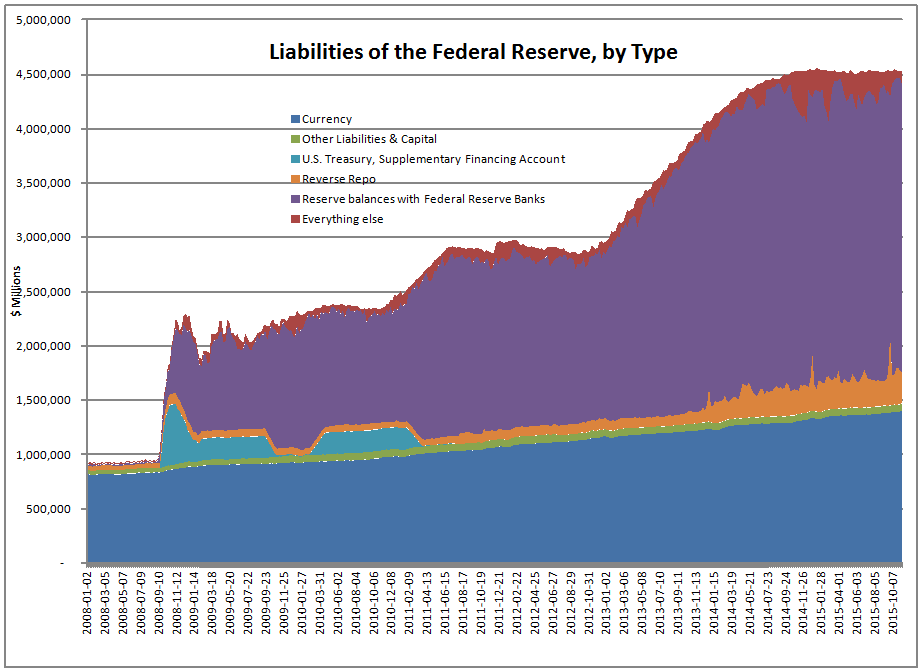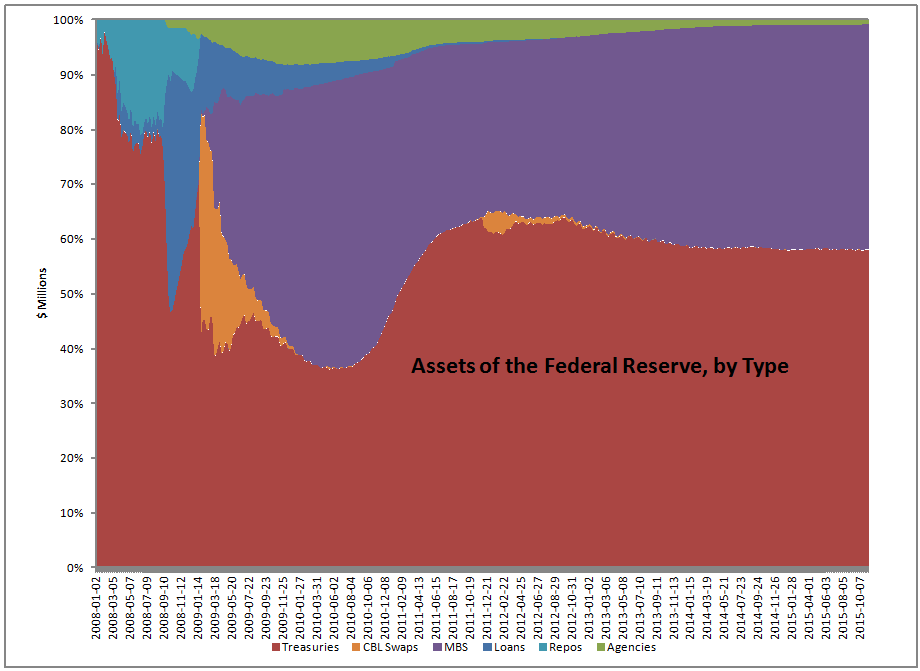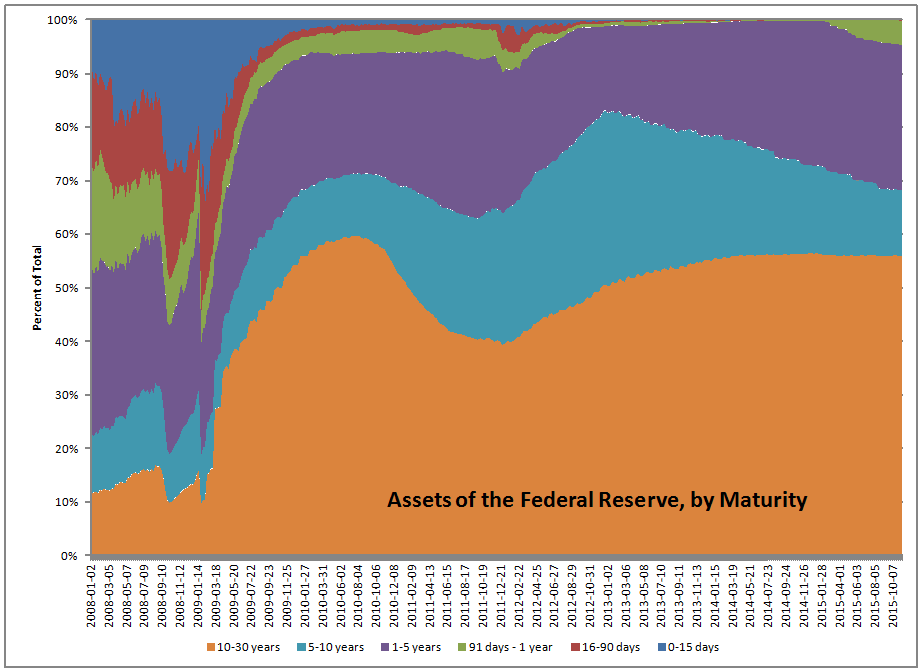
A while ago I wrote two pieces called “Easy In, Hard Out.” ?The main idea was to illustrate the difficulties that the Federal Reserve will face in removing policy accommodation. ? In the past, the greater the easing cycle, the harder the tightening cycle. ?I don’t think this time will be any different.
In the last two pieces, I showed three graphs to illustrate how the Fed’s balance sheet has changed. ?I’m going to show them again now, updated to 11/11/2015. ?Here’s the graph showing the liabilities of the Federal Reserve — i.e. what the Fed eventually has to pay back, occasionally with interest:
I’ve added a new category since last time — reverse repurchase agreements (“reverse repos”) because it has gotten big. ?In that category, you have money market funds (etc.) lending to the Fed to pick up a pittance in interest.
As you might note — as the balance sheet has grown, all categories of liabilities have grown. ?The pristine balance sheet composed mostly of currency is no more — it is only around 30% of the liabilities now. ?The biggest increase in reserve balances at the Fed — banks lending to the Fed to receive a pittance in interest, because they have nothing better to do for now.
I’ve considered doing an experiment, and I might do it over the next few weeks. ?I went to my copy of AAII Stock Investor, and pulled out the contact data for 336 banks with market capitalizations of over $100 million. ?I was thinking of calling 10 of them at random, and asking the following questions:
- What has the Fed’s ZIRP policy done to your business?
- Do you have a lot of money on deposit at the Federal Reserve?
- When the Fed raises the short-term interest rate, what do you plan on doing?
- Then, the same questions asking them about their competitors.
- Finally, who has the most to lose in this situation?
It could be revealing, or it could be a zonk.
One more interesting note: reverse repos and my “all other” category have become increasingly volatile of late.
Here’s my next graph, with the asset class composition of the Fed’s balance sheet:
The Fed has gone from a pristine balance sheet of 95% Treasuries to one of 60/40 Treasuries and Mortgage-backed securities [MBS]. ?MBS are?considerably less liquid than Treasuries, particularly when you are the largest holder of them by a wide margin — I’ve heard that it is 25% of the market. ?The moment that it would become public knowledge that you were a seller, the market would re-rate down in price considerably, until holders became compensated for the risk of more MBS supply.
Finally, here is the maturity graph for the assets owned by the Fed:
The pristine balance sheet of 2008 was very short in its interest rate sensitivity for its assets — maybe 3?years average at most. ?Now maybe the average maturity is 12? ?I think it is longer…
Does anybody remember when I wrote a series of very unpopular pieces back in 2008 defending mark-to-market accounting? ?Those made me very unpopular inside Finacorp, the now-defunct firm I worked for back then.
I see three hands raised. ?My, how time flies. ?For the three of you, do you remember what the toxic balance sheet combination is? ?The one lady is raising her hand. ?The lady has it right — Illiquid assets and liquid liabilities!
In a minor way, that is the Fed now. ?Their liabilities will reprice little as they raise rates, while the market value of their assets will fall harder if the yield curve moves in a parallel shift. ?No guarantee of a parallel shift, though — and I think the long end may not budge, as in 2004-7. ?Either way though, the income of the Fed will decline rapidly, and any adjustment to their balance sheet will prove difficult to achieve.
What’s that, you say? ?The Fed doesn’t mark its assets to market? ?You got it. ?But cash flows don’t change as a result of accounting.
Now, there is one bit of complexity here that was rumored at the Cato Conference — supposedly the Fed doesn’t use a prepayment model with its MBS. ?If anyone has better info on that, let me know. ?If true, the average life figures which are mostly in the 10-30 years bucket are highly suspect.
As a result of the no-mark-to-market accounting, the Fed won’t show deterioration of its balance sheet in any conventional way. ?But you could see seigniorage — the excess interest paid to the US Treasury go negative, and the dividend to its owner banks suspended/delayed for a time if rates rose enough. ?Asking the banks to buy more stock in the Federal Reserve would also be a possibility if things got bad enough — i.e., where the future cash flows from the assets could never pay all of the liabilities. ?(Yes, they could print money together with the Treasury, but that has issues of its own. ?Everything the Fed has done with credit so far has been sterile. ?No helicopter drop of money yet.)
Of course, if interest rates rose that much, the US Treasury’s future deficits would balloon, and there would be a lot of political pressure to keep interest rates low if possible. ?Remember, central banks are political creatures, much as their independence is advertised.
Conclusion?
Ugh. ?The conclusions of my last two pieces were nuanced. ?This one is?not. ?My main point is this: even with the great powers that a central bank has, the next tightening cycle has ample reason for large negative surprises, leading to a premature end of the tightening cycle, and more muddling thereafter, or possibly, some scenario that the Treasury and Fed can’t control.
Be ready, and take some risk off the table.




FED-Treasury are basically hedged. If interest rates rise on what the FED owns (various US treasury bonds) then that means inflation is rising/growth improving. So taxes would be booming. Fed would lose financially but the treasury would be profiting a ton.